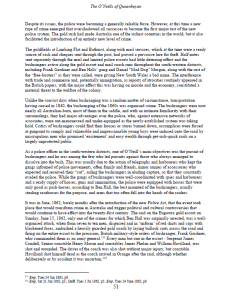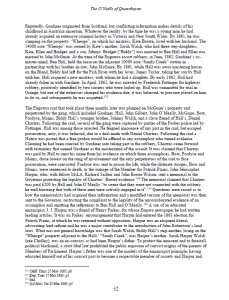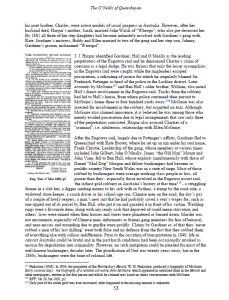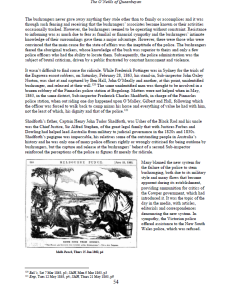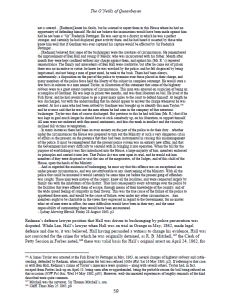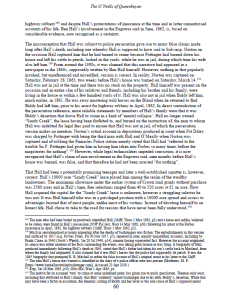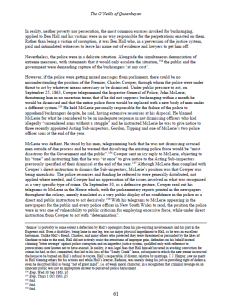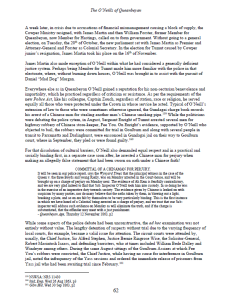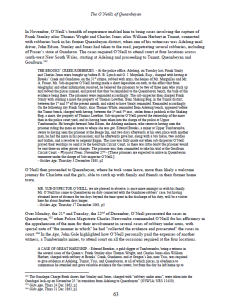What really happened at Jugiong
“…the murder of sergeant Parry was probably the first murder that could be brought home to the offenders Gilbert and Hall…”
So wrote the Inspector-General of Police, John McLerie, to the Colonial Secretary, William Forster, on November 23, 1864, setting in motion the series of events that would lead to the downfall of Ben Hall and the gang that had terrorised outback New South Wales for three years.
A week earlier, on November 16, Ben Hall, John Gilbert and John Dunn were waiting to ambush the Gundagai mail coach on its way to Yass. Fore-warned of a potential assault, Sub-inspector William Gregg O’Neill and Sergeant Edmund Parry of the Gundagai police rode behind the coach ready to come forward to meet any attack. Riding beside the driver was constable William Roche of the Yass police, escorting the coach on its return journey, and inside the cab, one passenger, twenty-seven year old Gundagai Police Magistrate, Alfred Cyrus Spencer Rose, sat with the curtains closed and no expectation of what awaited them.
As the coach approached a hill four miles outside Jugiong, the coach driver signalled to O’Neill and Parry, who rode up to the coach and saw what the others had – about forty people being held at gunpoint by three heavily armed men ranged at the top of the hill, who, when they saw the police, thinking there were “only two of them”, deliberately bore down on them in a determined attack, shooting with intent to kill.
Hall and Dunn engaged O’Neill who, under heavy gunfire, fought it out with them until he was out of ammunition, at which point he struck a blow to Hall’s head with the butt of his carbine. Gilbert, meanwhile, took on Sergeant Parry, firing on him while calling on him to surrender, to which Parry shouted “Never!” and for which Parry shot him in the back.
O’Neill was one of the best police officers in the force with an unprecedented reputation and his preparations for an attack had been well above and beyond the usual, but by the end of the afternoon, Sgt Parry had been shot dead, constable Roche had fled into the bush with the arms and ammunition and O’Neill had been forced to surrender, with Hall and Dunn on either side of him holding their guns at his head.
Why? The real reason has been locked behind rumour and folklore for over a hundred years – until now. The events at Jugiong became the basis of two inquiries, one in public, the other behind closed doors, and both are covered in detail in The O’Neills of Queanbeyan.
One incredible fact disclosed during the public hearing into the constable who fled was that, out of fear the bushrangers would turn their attention to the coach, Police Magistrate Rose had ordered him not to fire. At the time, the police were under requirement to obey the instructions of any magistrate in the territory and, accordingly, constable Roche had complied. O’Neill’s response to that was straightforward and direct – when he found Roche the next day he removed him of his arms, saying he was not fit to wear them, dismissed him from the force and had him charged with desertion. It was at the public hearing into Roche’s desertion that the Police Magistrate admitted his part in the events that had led to Parry’s death. An equally unimpressed Premier, Charles Cowper, exclaimed his disdain for Rose’s action in ordering Roche to desert his colleagues during a second inquiry held into the encounter held many months later, an inquiry made necessary by the deaths of Hall and Gilbert.
Although never made public, much more was also revealed and with the true details of the Colonial Secretary’s private inquiry related for the first time in The O’Neills of Queanbeyan, finally, what really happened at Jugiong and what it meant for bushranging history can be examined.
Immediately following the murder of Sgt Parry, Warrants had been issued for the arrest of John Gilbert for murder and Ben Hall and John Dunn for aiding and abetting. Contrary to what has become popular belief, Insp-gen. McLerie wanted the gang to be captured alive and put on trial so that the details of the Jugiong raid could be heard in court in public. However, while Parry’s was the first murder that could be definitively placed at the Hall gang’s feet, it was not the last and by May, 1865, Hall had been shot dead, soon followed by Gilbert in June. Dunn had escaped, but following his dramatic capture, escape and re-capture he was sentenced to death for the murder of another innocent police officer, Constable Nelson, who teenager Dunn shot with a gun Ben Hall put into his hand with the instruction to “manage the situation”, during a raid at Collector, rendering a trial for the events at Jugiong unnecessary. In March, 1866, still a teenager, Dunn was hanged, a pitiful end for a boy enticed onto the road by unscrupulous men.
At the same time that Dunn was awaiting the gallows in Darlinghurst, O’Neill was experiencing a battle of a different kind. With the aid of the press, the public and one of the most incisive minds in Australia’s history, that of the Colonial Secretary at the time, Charles Cowper, he had survived the encounter at Jugiong with his reputation intact, but, still venturing where angels fear to tread, he soon found himself facing a whole new level of danger after he arrested the Chief Justice’s nephew for cheque fraud and the President of the Legislative Council’s former cattle overseer – for cattle-stealing. At no time was the Chief Justice, Alfred Stephen, one of the great men in Australia’s judicial history, himself implicated in any wrongdoing by his nephew or the controversial events that surrounded him, but the scandal that arose from it was such that he almost resigned.
With the aid of documents from the Colonial Secretary’s files never before made public and much other research, the raid at Jugiong is described in The O’Neills of Queanbeyan in a level of detail never before covered in Australian history, as is the career of a police officer once described as being among only a few worthy of the name.
By the early 1900s, the truth surrounding Ben Hall and his gang had been superseded by myth and total concoction, as had the reputation of the New South Wales police, the folklore surrounding bushranging having assumed such proportions as to make exposure, discussion and analysis of real events difficult for even the best of historians.
It’s time to bust the myths. Ben Hall was not a struggling selector nor an innocent man forced onto the road by police persecution. During a time that the average selector struggled on forty acres, by 1860, Ben Hall held the ten thousand acre “Sandy Creek” station on the Lachlan, in partnership with his brother-in-law, John McGuire, and adjacent to his mother-in-law’s even larger fourteen thousand acre “Wheogo” property. It’s not certain how Hall acquired the “Sandy Creek” lease, but it was prime land on which he held horses and stock he had obtained through long ‘cattle-duffing’ trips away from home.
“Wheogo” was owned by Sarah Walsh, who had three step-daughters, Kate, Ellen and Bridget, and a son, Johnny. Bridget (“Biddy”) was married to Ben Hall and Ellen was married to John McGuire. By 1861, the bushranger, Frank Gardiner, was camping on “Wheogo”, on which his mistress, Kate, still living with her husband. By 1861 also, while Hall was away mustering horses on the Bland, Biddy had left for the Fish River with her lover, James Taylor, taking her son by Hall with her. Hall acquired a new mistress, with whom he had a daughter.
By early 1862, Hall had already fallen in with Gardiner. In April, 1862, Hall was arrested by the head of the Lachlan police, Frederick Pottinger, for highway robbery. Positively identified by two carriers who were bailed up, Hall was committed for trial in Orange, but one of the witnesses changed his evidence due, it was believed, to pressure placed on him by Hall and subsequently Hall was acquitted.
Three months later, on Sunday, June 15, 1862, the Eugowra escort raid took place, when four police officers escorting a gold delivery were ambushed and shot in an organised assault. Seven to ten men, disguised and in ‘uniform’ of red shirts and caps with blackened faces, placed bullock carts across the road to halt the escort and, emerging from behind rocks and trees, surrounded the officers and fired on them to the precision, British military-style orders of Gardiner, who commanded them as an army general. Every man but one in the escort – Sergeant James Condell, Senior-constable Henry Moran and constables James Phelan and William Havilland, was shot and wounded. The driver of the coach was also shot without major injury but constable Havilland shot himself dead as the coach arrived in Orange after the raid, although whether deliberately or by accident it was uncertain.
The “Eugowra escort raid”, had been co-masterminded by Gardiner and Hall, planned on McGuire’s property and perpetrated by Gardiner, Hall, McGuire, John Gilbert, John O’Meally, Bow, Fordyce, Manns and Hall’s close friend, Daniel Chartres. Also recruited into the gang was Hall’s nephew by Biddy, her brother, the boy, Johnny Walsh, nicknamed “Warrigal”, who acted as Gardiner’s groom and scout. Following the raid, several of the gang were captured by parties of the Forbes police led by Pottinger. One of the perpetrators, Daniel Chartres, turned Crown evidence whereby only three of the perpetrators, the three illiterate stooges, Bow, Fordyce and Manns, were convicted.
Hall was among those originally arrested. He feigned innocence of any part in the raid but escaped prosecution, only, it was believed, due to a deal made with Daniel Chartres. A relative of Hall’s by marriage, Member of Parliament, J. J. Harpur, accused that Hall evaded conviction only because Hall paid Chartres £200 to leave his name out of his testimony. Hall also paid good money to his lawyer, William Redman, to my knowledge, identified for the first time by myself as the Member for Queanbeyan at the time, to get him off.
Frank Gardiner fled to Queensland with Kate, where under his real name, Christie, he owned an inn, until he too was captured and jailed. Under Ben Hall, the gang expanded their activities across New South Wales, from the Lachlan, penetrating Queanbeyan, Braidwood and Yass to Gundagai, where the Jugiong raid took place in 1864, and Collector, where another police officer, Constable Nelson was shot dead and Nelson’s unarmed son shot at. After two years of perpetrating hundreds of attacks and several murders had taken place at the hands of his gang, Hall was shot by NSW police in 1865.
At the time there was no doubt of Hall’s guilt but many years after his death, by the 1910s, tales had started to appear, only then giving rise to the myth that Hall had been a ‘folk-hero’. In 1921, an article by a journalist known for being somewhat fluid with the truth, claimed that Hall had apparently written a letter to a “local newspaper”. The paper to which the letter was supposedly sent is not identified and nor is a date noted. However, in 1863, Hall had captured police Sub-inspector Norton, who he sent back into town minus his horse and the dignity of the police. The letter claimed that on that occasion Hall had supposedly said to Norton that he had turned to bushranging because the police had “arrested him for nothing” and had “burned his house down while he was in jail, during which time his wife left him and his stock were left to perish”.
The myth about that letter has gained great circulation and has been the main basis for the persecution theory, appearing in many accounts of Hall’s supposed history. However, it’s a lie, a big lie. The letter is unverified and whether it existed or not, its contents are indisputably incorrect. The most likely paper for the letter to appear in would be the Lachlan Miner but there is no account of it, nor any reproduction of or reference to it in any other paper from the time, which is conspicuous. However, if it did exist and it was written or dictated by Hall, it would make him all the more a liar for it. It is correct that Ben Hall’s house was burned down, but the tale surrounding the circumstances of that event is pure fiction, not the least of which because Hall’s house was burned down two weeks after Hall captured Norton and it was not at the instigation of the police but Hall’s business partner, to whom Hall had forfeited the lease on his property for failure to repay the legal fees his partner had put up to get him off pre-existing offences, including the Eugowra escort raid. Moreover, Hall was not in jail at the time but was even present when it happened. He had been given Notice to Quit but ignored it, or at least so the new owner claimed, being why the owner had called the police, acting as bailiffs and led by Pottinger, to evict him. Hall turned up, attempting to lure the police away, but the police let him go, only part reason they came under intense condemnation. Hall’s wife, Biddy, had left him a long time earlier and he had another partner with whom he had another child. There was no stock on the property, his father purportedly having already taken it to Maitland, and Hall’s older brother and family, as well as Hall’s mother and his new partner, were all living on the property at the time, let alone the McGuires, barely three or four hundred yards from Hall’s house, any or all of whom could have cared for supposedly ‘abandoned’ stock, stock that in reality did not exist. However, the burning of Hall’s house was condemned in parliament, there being a woman and child on the property, as was Pottinger’s failure to pursue Hall when he tried to lure them away. Rather than chasing Hall, Pottinger seemed to have been willing to act on the owner’s instructions to burn down his house as his personal message to criminals that they could not act with impunity. However, whatever Pottinger’s role in this event, it had nothing to do with Hall turning to bushranging, he having been a seasoned and determined criminal for some time. From the time of European colonisation, there had been instances of injustice, brutalisation and persecution, however, Ben Hall’s experience was not one of them.
This was all well-known at the time of the events in the 1860s. Hall’s own family had no doubt of his guilt, including his part in the Eugowra raid. McGuire wrote of it in his memoirs, later penned by a newspaper editor from first-hand dictation, and Hall’s older brother also confirmed Hall’s involvement. Hall’s family never blamed the police for Hall’s turn to crime but attributed it to a type of “breakdown” they claimed he had after Biddy left him. Ben Hall and his gang had been a topic of detailed discussion in parliament since the Eugowra raid, including the burning of his house, which was condemned. However, sixty years after the events, the 1921 article that put in print rumours that had arisen long after Hall’s death, harnessed the up-the-system quality of the Australian national character and made a sanctified hero out of a thug, the repercussions of which are still being felt today.
The false Ben Hall legend arising from the 1920s was mainly a capitalisation of the circumstances surrounding Ned Kelly, who in reality, was active many years after Hall’s death. There were three main phases of bushranging in Australia – the bushranging of the pre-1840 convict age, the organised crime of the 1860s and a revival nearly twenty years later, mostly represented by the Kelly gang. All three phases had distinctive characteristics but all three have been merged as a singular iconification of ‘all’ bushrangers, however murderous or deranged, as innocent victims of persecution and systemic corruption. In that version, Ben Hall was cast as a man ‘never having harmed anyone but shot a million times without warning while innocently laying asleep in the bush’, when in reality, it was Hall and his gang who opened fire on police officers in unprovoked attacks, not the other way around as the false legend would have it, and he was not innocent of his part in the murders of several people. Curiously, Hall’s apologists omit any reference to the Eugowra assault, about which there is no doubt of his direct involvement. Likewise, that Hall led the many armed raids perpetrated by his gang, and nothing is said of the means by which he several times evaded conviction. There is no doubt of Hall’s intention to kill. At Jugiong, Hall, Gilbert and Dunn deliberately fired on O’Neill and Parry, thinking there were ‘only two of them’ and that. therefore, they could ‘take them’. Any of the bullets that passed through O’Neill’s black alpaca coat could have killed him and Parry was being chased when Gilbert shot him dead, in the back.
Questions have been raised as to the legality of the shooting of Ben Hall in May, 1865, on the basis that at the time of his death, technically, Hall had not yet been “outlawed” and therefore was not subject to the Felons Apprehension Act, whereby he could be shot on sight by anyone. It is correct that although the process to introduce the Act was in motion, Hall had not yet been officially outlawed. However, Hall was not shot by just ‘anyone’. He was shot by the Dubbo police while legally under arrest for attempted murder and refusing to surrender when called on to do so. Therefore, whether the Act was in force yet or not was irrelevant. No such consideration had been accorded Sgt Parry by the gang when Gilbert intentionally shot him for refusing to ‘surrender’, nor to constable Nelson nor any others, civilian or police, held at gunpoint, shot at or murdered by whatever means, “legally” proven or not, under Hall’s leadership.
N. B. From documents held at the NSW State Archives, for the first time in public also, I have been able to identify Sgt Parry as a police officer previously mistaken in a newspaper account as “Perry”, who was called to “Round Hill” when Daniel “Mad Dog” Morgan held up Henty’s station and murdered innocent station-hand, John McLean. At the height of Morgan’s atrocities, O’Neill had been called in from Gundagai to Albury to lead pursuits of Morgan and it was then that Parry was transferred to be under O’Neill’s command in Gundagai.
There is no doubt Hall had shown promise as a young man, a talented stock-rider, potentially able to rise above the convict origins of his parents, as had his relative by marriage, the Member of Parliament and protégé of Sir Henry Parkes, J. J. Harpur. Why Hall took to the road in a supposed ‘sudden’ turn to crime has been a matter of passionate speculation, but it is speculation fuelled by misinformation promulgated many years after real events had long passed from public memory.
There are marked similarities between Gardiner and Halls’ gang and the notorious Clarke-Connell gang that lived in the Jingerra mountains straddling the Queanbeyan and Braidwood districts and it is no coincidence that they were at times collaborators. They each consisted of an entire clan of families and associates, with similar antecedents and lack of socialising influences, living within large tracts of land, geographically favoured by isolating terrain. This and more specific circumstances in Hall’s life, including a riding accident that left him lame in one leg as a boy, may provide sufficient explanation for the lifestyle he chose to adopt.
The following excerpts from The O’Neills of Queanbeyan go some way toward returning to the realms of reality a man around whom dangerous myths have been woven which mask only the truth about significant events and a lot of genuinely good people.
The chapter on William Gregg O’Neill in The O’Neills of Queanbeyan covers O’Neill’s career and the relationship between the bushrangers and the police during a time that the police were under scrutiny and political debate surrounded the introduction of the new Police Regulation Act in 1862.
N.B. I’ve recently had excellent conversations with Peter Bradley, a relative of Ben Hall, and author of two books on him – Ben Hall: Stories from the Hard Road and The Judas Covenant, in which he makes a case for the identification of the man who sold Hall out to the police, following which Hall was shot. Peter feels I make Hall appear too wealthy. He points out Hall’s relatively primitive living conditions and in his books, he notes further information as to the Sandy Creek lease and the quality of the land and surrounds in the Pinnacles.
For background as to Ben Hall and his gang specifically, Mark Paul Matthews’ website, “Ben Hall, Australian Bushranger” https://www.benhallaustralianbushranger.com/, provides detailed information. Importantly, Matthews provides an image from the diary of a police officer who was present when Ben Hall’s house was burned, identifying the date on which it took place, with this information having originated with Peter Bradley. I note this is two weeks before Norton was captured and therefore it provides direct evidence of a pivotal piece of information that dispenses with the persecution fallacy surrounding Ben Hall that arose after his death.
Matthews makes a connection between Gardiner and Halls’ gang and the outlaws of the American west, which he also refers to on his website. In 1874, Gardiner was released from prison under condition he leave New South Wales. He was rumoured to have fled to San Francisco, where he ran a hotel at which it was claimed he engaged in tales of his exploits and after which, the American outlaws emerged, from similar origins and operating in similar style. Was Gardiner an unfortunate Australian export?

